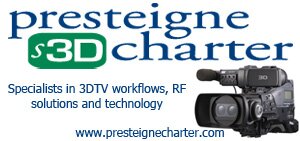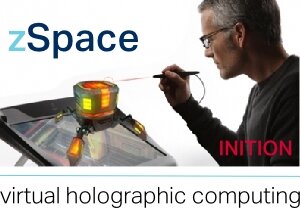Exclusive Behind the Scenes Look at BAIT 3D
Due for release in 2012, BAIT 3D is a natively shot 3D movie about a freak tsunami which traps shoppers at a coastal Australian supermarket inside the building … along with some great white sharks.
Directed by Kimble Rendall (Matrix Reloaded, I Robot), and produced by Arclight Films with stereography expertise supplied by Inition, BAIT in 3D faced a series of challenges, from filming underwater sequences with beamsplitter rigs to creating a version specifically for the Chinese market.
In this exclusive interview, stereographer Markus Stone, Head of Production for Inition Asia Pacific and Mike Gabrawy, Head of Production from Arclight Films, provide some fascinating behind-the-scenes insights.
(The film screenshots are taken from both the Chinese and international version) Edited by Philip Bridges
 3D Focus: What is the premise of BAIT 3D?
3D Focus: What is the premise of BAIT 3D?
Mike Gabrawy: A freak tsunami hits Australia's Gold Coast and floods a small seaside town's grocery store and car-park with great white sharks.
3D Focus: How was BAIT 3D conceived?
Mike Gabrawy: Gary Hamilton's Arclight Films picked up a script written by Russell Mulcahy at the end of 2008 and developed it internally. Arclight ultimately partnered with high-profile Queensland based producers Chris Brown and Todd Fellman to development, finance and produce BAIT 3D. The production was very well received at the Cannes Film Market in 2009 which gave BAIT 3D the market traction to garner support from both the Australian and Singaporean government bodies. .
3D Focus: At what point during the pre-production process was it decided to film BAIT in 3D?

Mike Gabrawy: The film was originally envisaged as a 2D film however, through the development process, Arclight realised that the material had enormous potential and was ultimately better suited to be shot in stereo 3D.
Markus Stone: I was talking to the producers about the 3D 6 months before production started; before the funding had even come through.
3D Focus: How important is a cinema release these days for the financial success of any movie? Can production companies still make a return over the long term from television licensing, non-theatrical rights, 3D Blu-ray, connected TV, online etc?

Mike Gabrawy: Cinema release is critical for many films but especially so for 3D, where the creative process is specifically targeted at the theatrical experience. A proper theatrical release is critical to elevate awareness for films in an increasingly crowded ancillary market.
3D Focus: Director Gareth Roberts told 3D Focus that he would not make another film in 3D, at least for a while, and has struggled to get distribution for his 3D film, The Mortician, claiming that distributors are thinking that because it is a film noir style of movie, the public would not accept it in 3D. Do you agree? Do you think action/dramas like BAIT 3D are still the only commercially viable genre for 3D right now (aside from animation).
Markus Stone: I think the success of any individual film has more to do with the film itself. A film that struggles to find an audience will not be saved by being 3D. We need to make good films first, films that would find an audience in 2D – the 3D is then a way of adding value to that investment.
I don't think it's true to say that only certain genres 'work' in 3D. While the visual richness of certain genres does tend to work better in 3D than others, it would be quite possible to have a romantic comedy set in a forest village that looks more impressive in 3D than an action adventure movie set in a bare prison. It all depends upon how much information the viewer is getting from all depths throughout the frame. A common misconception is that having objects really close to camera will make things look great in 3D. In fact the opposite is true – it's far more important to make sure there is a mid-ground as well, rather than just a foreground and a background.

3D Focus: Is this all out horror?
Markus Stone: It's not a slasher movie, it's smarter than that. There's a fair bit of suspense, so I'd call it Thriller/Horror
3D Focus: Were the actors excited about being in a 3D movie?
Markus Stone: They were certainly interested in the technology. After a big 3D shot they' would all cluster around the monitors wearing the 3D glasses to see how it looked in 3D.
3D Focus: We have had Jaws, Pirannha, Amphibious and Shark Night as well as several underwater 3D documentaries – why 3D and underwater themes?
Markus Stone: It goes back further than that – think Ghosts of the Abyss, or all those IMAX documentaries. I think films just like to explore other worlds and alternate realities. Underwater worlds are another place to explore, as evidenced by Avatar 2 in development.
3D Focus: With 3D production costs coming down, what approximate percentage do you think 3D added to the budget?
Markus Stone: I believe it was in the area of 30-40%.

3D Focus: Free-to-Air 3D transmitters have been taken down in Australia due to a lack of demand – Overall, what is the appetite for 3D in Australia?
Markus Stone: TV is a different animal from cinema. The situation with TV in Australia is that, while advertising revenue stays the same, the costs of production increases for a 3D program, so without some sort of sponsorship, it can be difficult for 3D broadcasters to find a financial model that works; especially when the percentage of audience with 3D TV's is so small. In the cinema, people go because they want the big theatrical experience, and 3D is part of that.
3D Focus: Filming underwater in 3D must present a challenge due to all the reflections of light – why did you decide to film such an aquatic film in 3D rather than convert it in post?
Markus Stone: A big part of it is that shooting in 3D always looks better than (even a good) conversion. The sense of space is more contiguous and realistic with none of the edge artefacts that you get from conversions. We were essentially going for the best quality we could get and stereoscopic underwater shooting was part of that. In terms of reflections, we didn't really have any issues as the underwater housing was designed to deal with them with anti-reflective coatings and having the mat-box sit right on the port.
3D Focus: I understand that you used the world’s first beamsplitter designed for underwater filming. Can you tell me a bit more about that? Was it created by yourselves? And how did it solve the reflection issues?
Markus Stone: The underwater housing was designed by Simon Christides, the underwater DoP on the project. It housed 2 x SI-2K heads mounted on an Element Technica Neutron rig. All cables came out a port in the side through which we also pumped compressed air to provide some heat exchange. The ability to get close underwater is important if you want to see emotion in someone's eyes through a facemask. In side by side mode, you are limited by how close you can get the cameras together. In scenes where there is blood and guts floating in the water, you can't wrangle something like that, and you need to be able to control how much it 'pops' by varying the interocular (interaxial, internodal) distance.

3D Focus: What cameras and lenses did you use?
Markus Stone: We used zooms – the 19-90mm Primo's on the A rig, and the Angenieux 15-40 Optimos on the B rig. We went for zooms because the camera was either packed into a splashbox, or mounted on a crane. The time required to get  access to the cameras and change lenses (then re-align) was something we couldn't afford on set, so zooms were the obvious choice. For that, it was essential that they tracked well throughout the zoom range and matched well optically, otherwise it would not have been possible.
access to the cameras and change lenses (then re-align) was something we couldn't afford on set, so zooms were the obvious choice. For that, it was essential that they tracked well throughout the zoom range and matched well optically, otherwise it would not have been possible.

In terms of the cameras themselves, Red MX were really the only cameras available at the time that shot at resolutions higher than 2K. Alexas hadn't hit the ground yet and the first RED EPICS were still months away. The 4K resolution was important to us because the latitude it gave us in post to play with convergence without sacrificing resolution. 3D resolution in the cinema is 2K per eye for bandwidth reasons, so that's your master format. We were essentially shooting 4K for a 2K master.
If we'd gone with any of the other HD options out there (Genesis, or the F950's used on Avatar), you'd be shooting at a lower resolution and blowing up to a 2K master, and any tweaks to the convergence would come at the cost of resolution. For the Chinese version we did have the luxury of using the Alexas recording to OB-1's using the same rigs and lenses.
3D Focus: What problems did you have on set specifically related to the 3D element?
 Markus Stone: On a shot to shot basis, there was really no difference. We'd rehearse and get our marks at the same time as the focus puller and be ready to go by the time ‘action’ was called. The difference came in changing setups. The cameras were big and heavy, requiring a Russian made Lev head to drive it from a Technocrane. If the camera had to come off we used engine hoists. The monitoring situation is also a lot more complicated for 3D and a change of setup can mean a lot of cable wrangling for the guys, which translates into more time before you get pictures back up and are ready to line up the next shot.
Markus Stone: On a shot to shot basis, there was really no difference. We'd rehearse and get our marks at the same time as the focus puller and be ready to go by the time ‘action’ was called. The difference came in changing setups. The cameras were big and heavy, requiring a Russian made Lev head to drive it from a Technocrane. If the camera had to come off we used engine hoists. The monitoring situation is also a lot more complicated for 3D and a change of setup can mean a lot of cable wrangling for the guys, which translates into more time before you get pictures back up and are ready to line up the next shot.
There is also an extra layer of technology that needs to be looked after, like making sure your lens control is synchronous on both lenses. Sometimes they'd go out and we'd have to re-calibrate the preston, but it wasn't a big deal.
3D Focus: BAIT 3D looks like quite a dark film and some directors light their sets very brightly with shadows added in post to offset the darkness of 3D projection. Did you do anything similar?
Markus Stone: I didn't really have any issues with the lighting. I was constantly on the lookout for reflection issues, which I'd work with Ross Emery, the DoP on the project, to solve in the best way possible. Sometimes he'd order a light to be tweaked, a cutter to be brought in, or as a last resort we'd apply dulling spray. The main thing with a dark film is keeping an eye on ghosting on bright elements that have a lot of parallax. You have to keep in mind that the film will have a 2D release as well, and has to look good in both formats.
3D Focus: What is the rationale behind shooting a different version of BAIT 3D for the Chinese market? What scenes were added/changed/deleted and what were the reasons for these decisions?
Markus Stone: I don't know the ins and outs of that – it all happened at an 'above the line' level. My understanding is simply that the Chinese distributors wanted a film that would resonate more with Chinese audiences. By expanding on one of the storylines of the original film, a separate, yet interwoven story was able to be incorporated that introduced some new characters, and increased the participation of some of those from the original film.
3D Focus: Markus Stone has said that Inition supplied consulting on storyboards, pre production testing and troubleshooting. Can you explain that process? How do you storyboard a 3D movie?
Markus Stone: Essentially I had a chat to Ross and Kimble about what works in 3D. They had done a lot of research themselves and were pretty on top of it. Then it was a matter of looking at the storyboards for anything that might prove troublesome for 3D, discussing it and finding ways to solve the problems.
The pipeline process was quite involved and covered everything from how best to monitor on set, how playback would work, and once captured, how to get the data through the various systems and out the other end in one piece; as well as establishing a VFX workflow, and how any 3D tweaks or match-grading would integrate with the other processes.

3D Focus: Did you do anything specifically with the audio on BAIT 3D to match the 3D visuals?
Mike Gabrawy: With a film as elaborate as BAIT 3D the sound design and VFX are characters in the film. We endeavoured to capture the terror of a post Tsunami world through sound design that reflects being trapped in a flooded building with water pouring in around electricity and on-going earthquakes destabilizing the structure. The results are frightening.
3D Focus: How long did the actual shoot (not preplanning or post production) take?
Markus Stone: 45 days shooting and an extra 20 days on the Chinese version.
3D Focus: I hear people say they learn new things after every 3D shoot they do – what, if any, were the lessons learnt from BAIT 3D?
Markus Stone: I learned a lot about how reflections work with 3D, and which ones cause problems and how to solve them (this was the days before 1/4 wave retarders). I also learned a lot about shooting in water regarding how far you can go when you have water right up on the port, or particles floating in frame. In the beginning we weren't entirely sure how it would work having water right up on the port, but after we did some tests, we found that in many situations it actually added to the sense of space, rather than being a handicap.

BAIT will be released in 2D and 3D in 2012 with the date to be confirmed.
3D Focus would like to thank Arclight Films and Inition for making this feature happen. You can read more about Arclight Films here and more about Inition here.
EXCLUSIVE BAIT 3D BEHIND THE SCENES GALLERY

FREE WEEKLY 3D NEWS BULLETIN –




















Pingback: BAIT 3D: Press Release Information, Official Trailer & Exclusive Behind the Scenes « Phoebe Tonkin Network: Your leading source dedicated to Phoebe Tonkin & Fans
Pingback: Xavier Samuel: Nuevas imagenes del Behind the Scenes desde BAIT 3D « The Vampire Club
Pingback:
Pingback: Go Behind-the-Scenes Of That Other Shark Flick, ‘Bait 3D’ | Bloody Disgusting